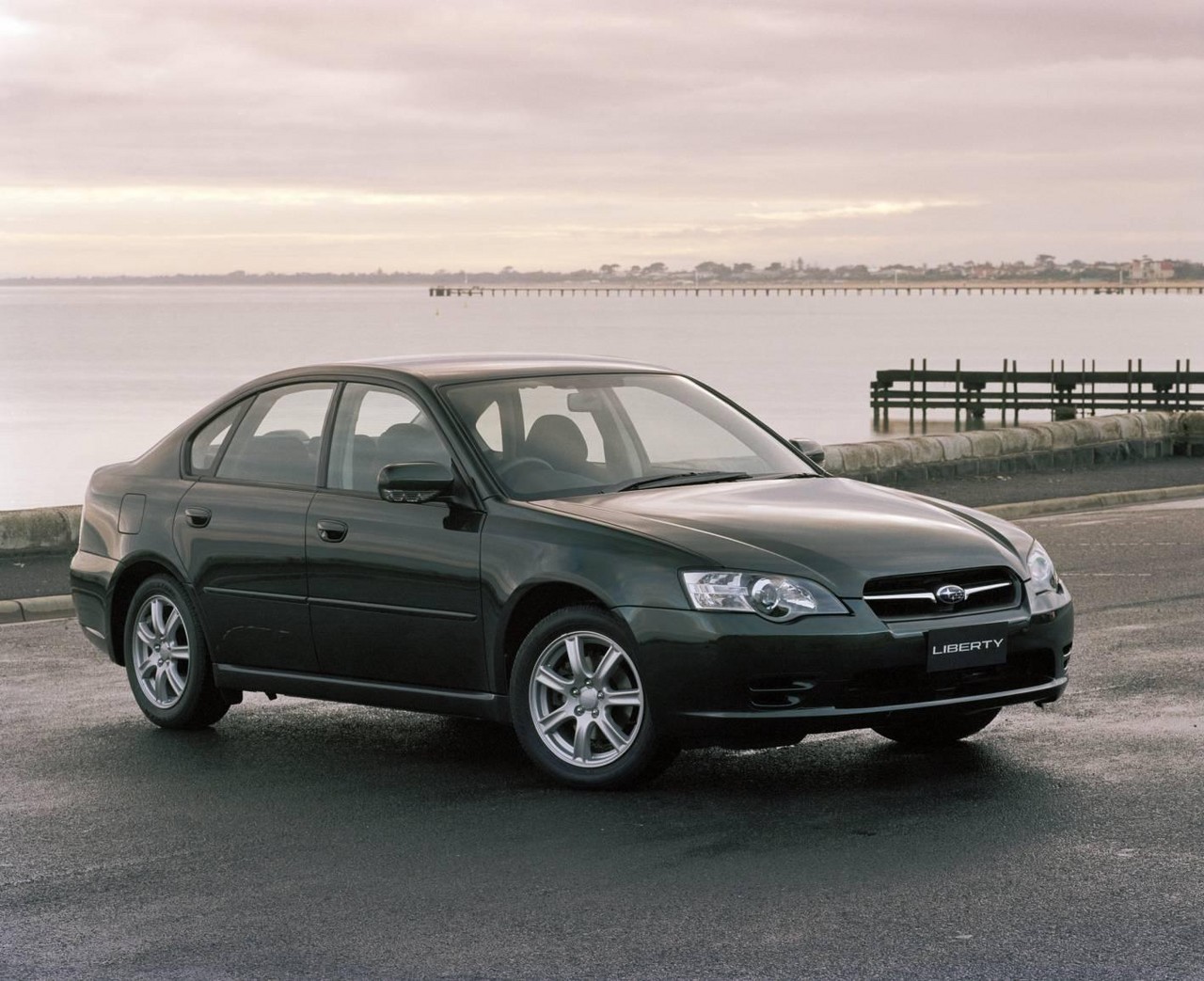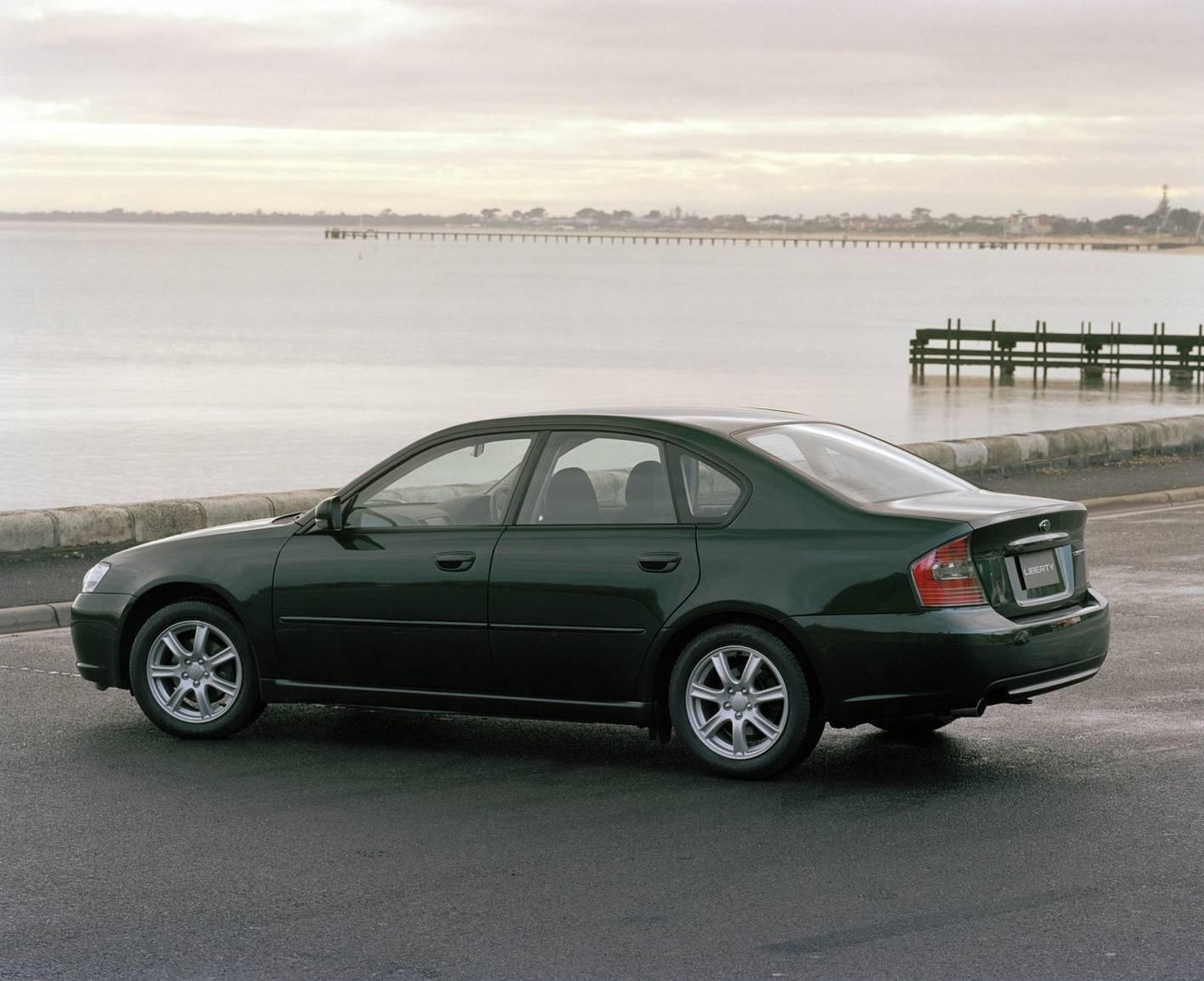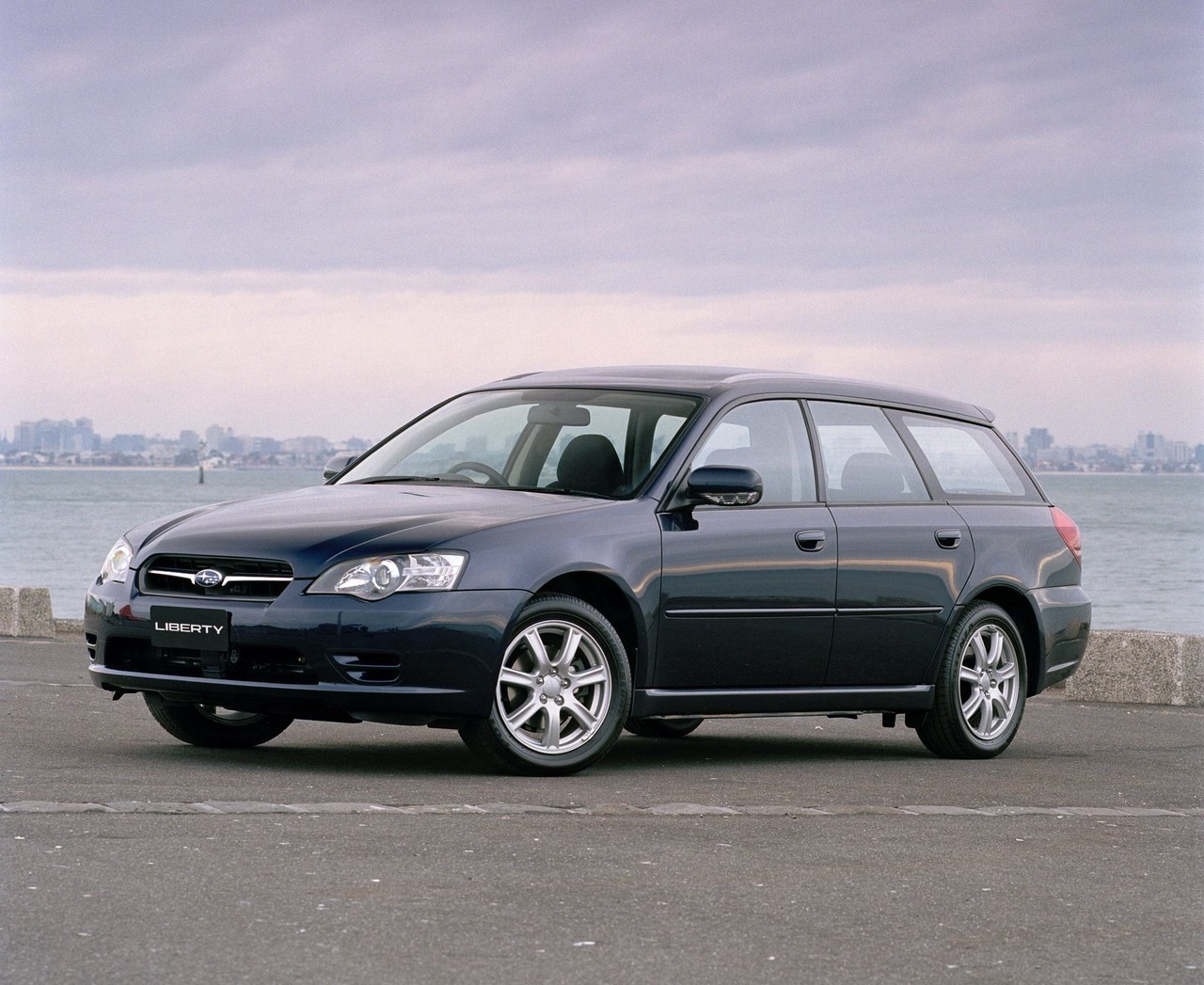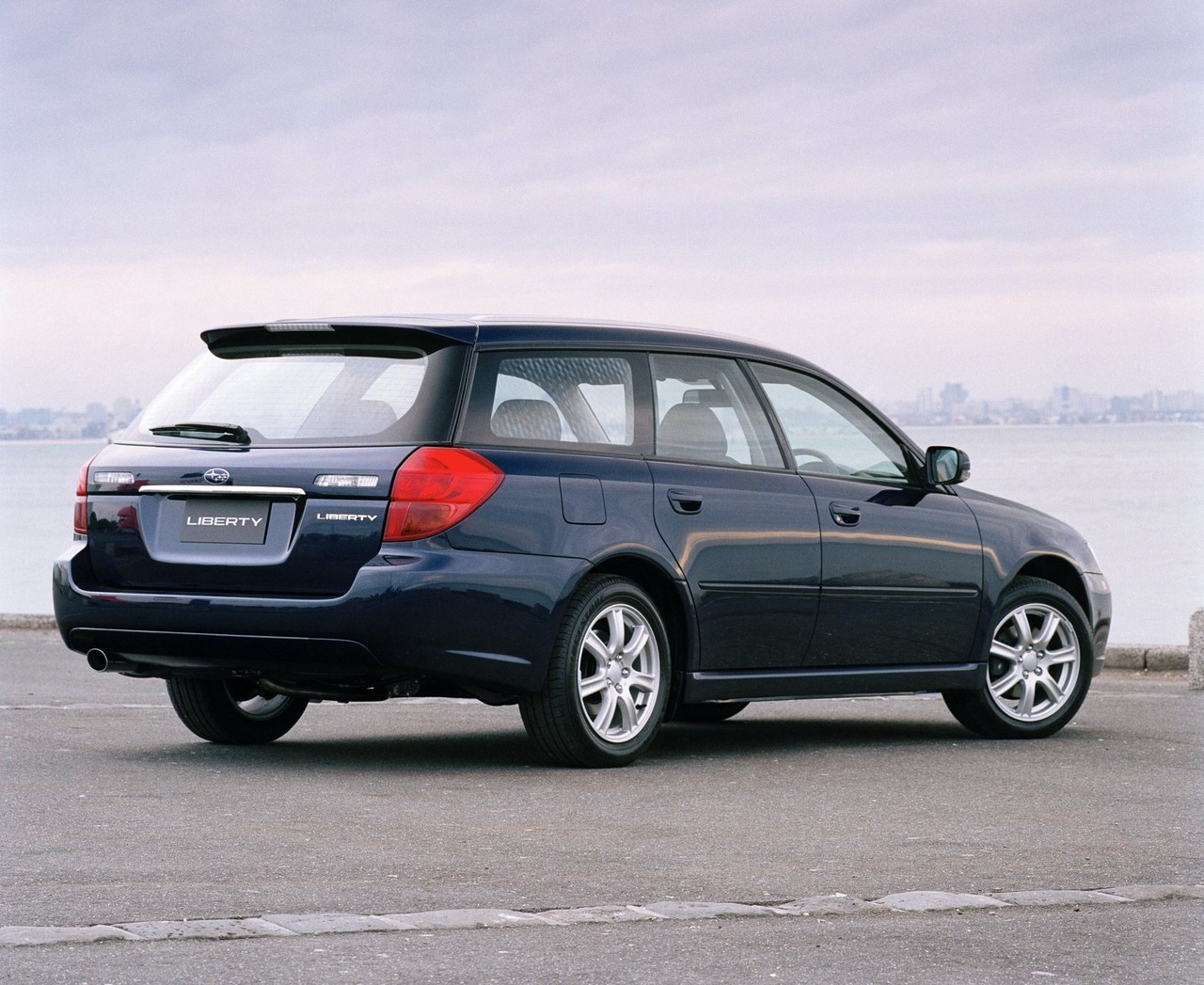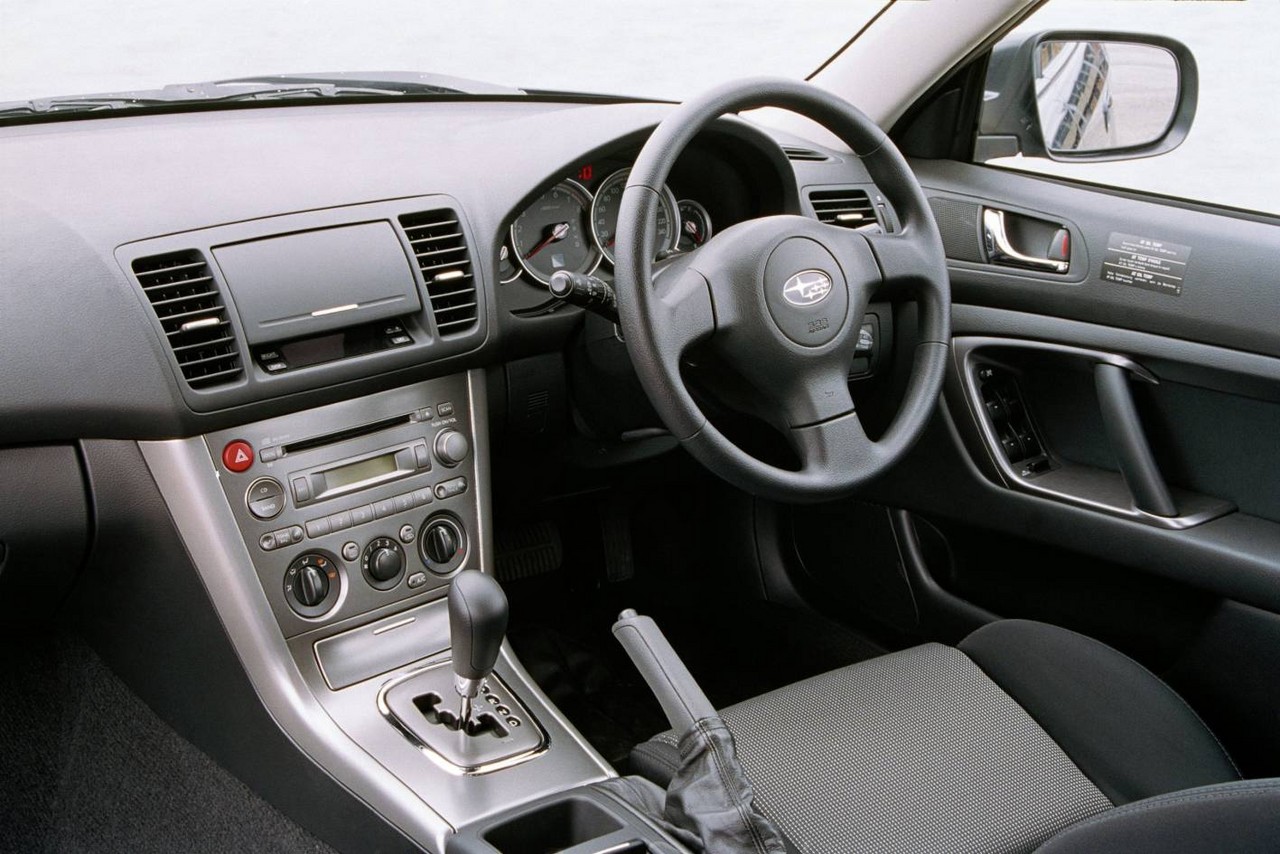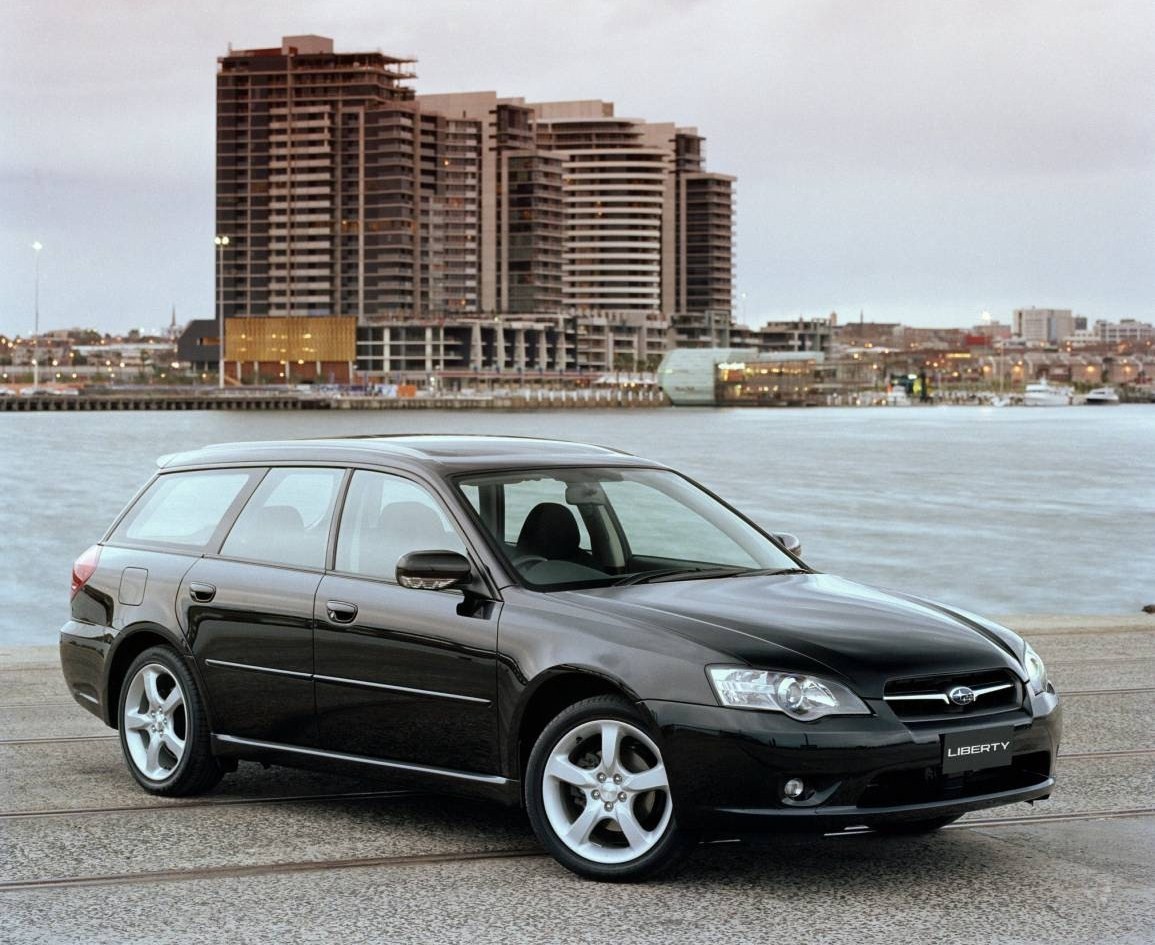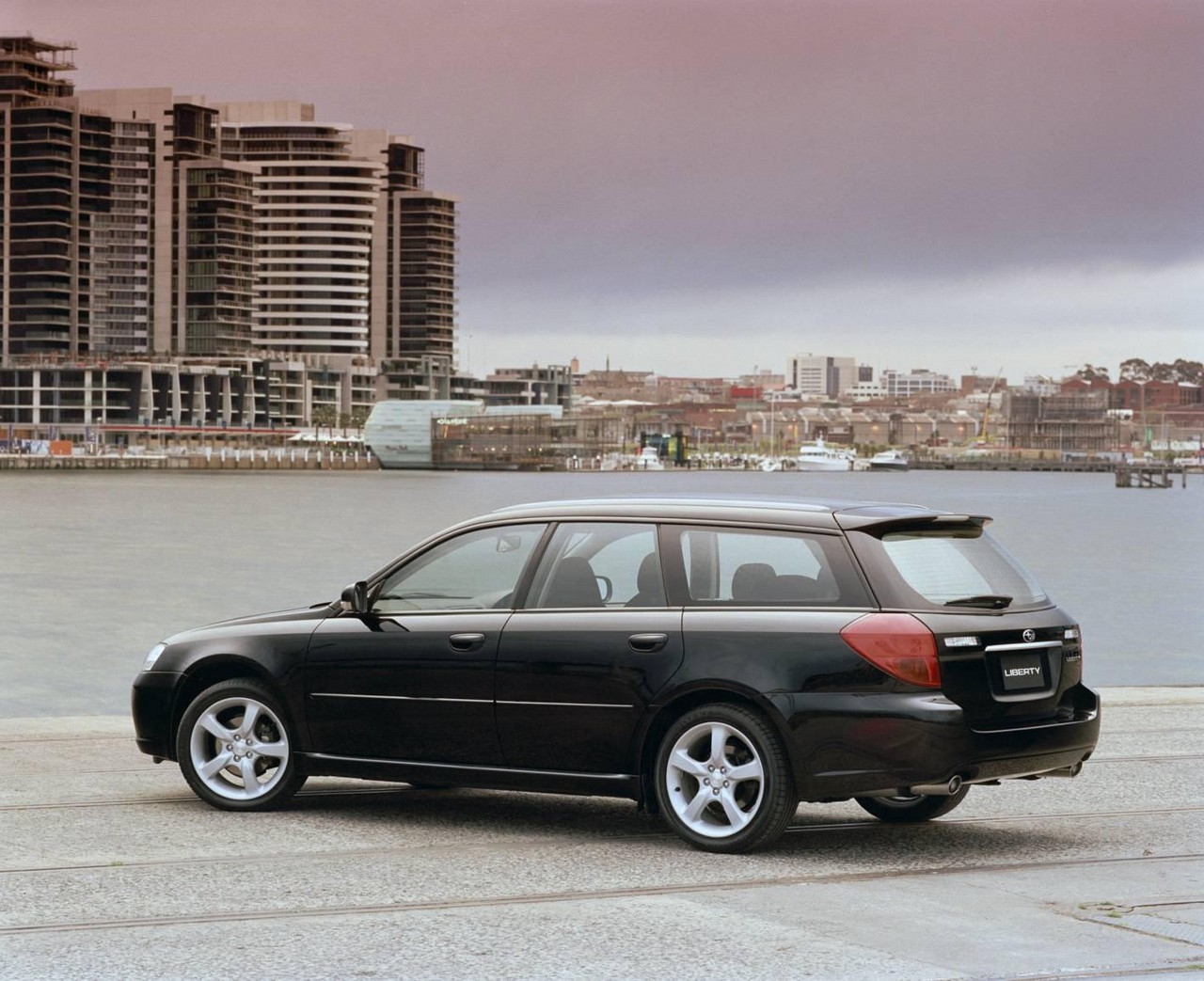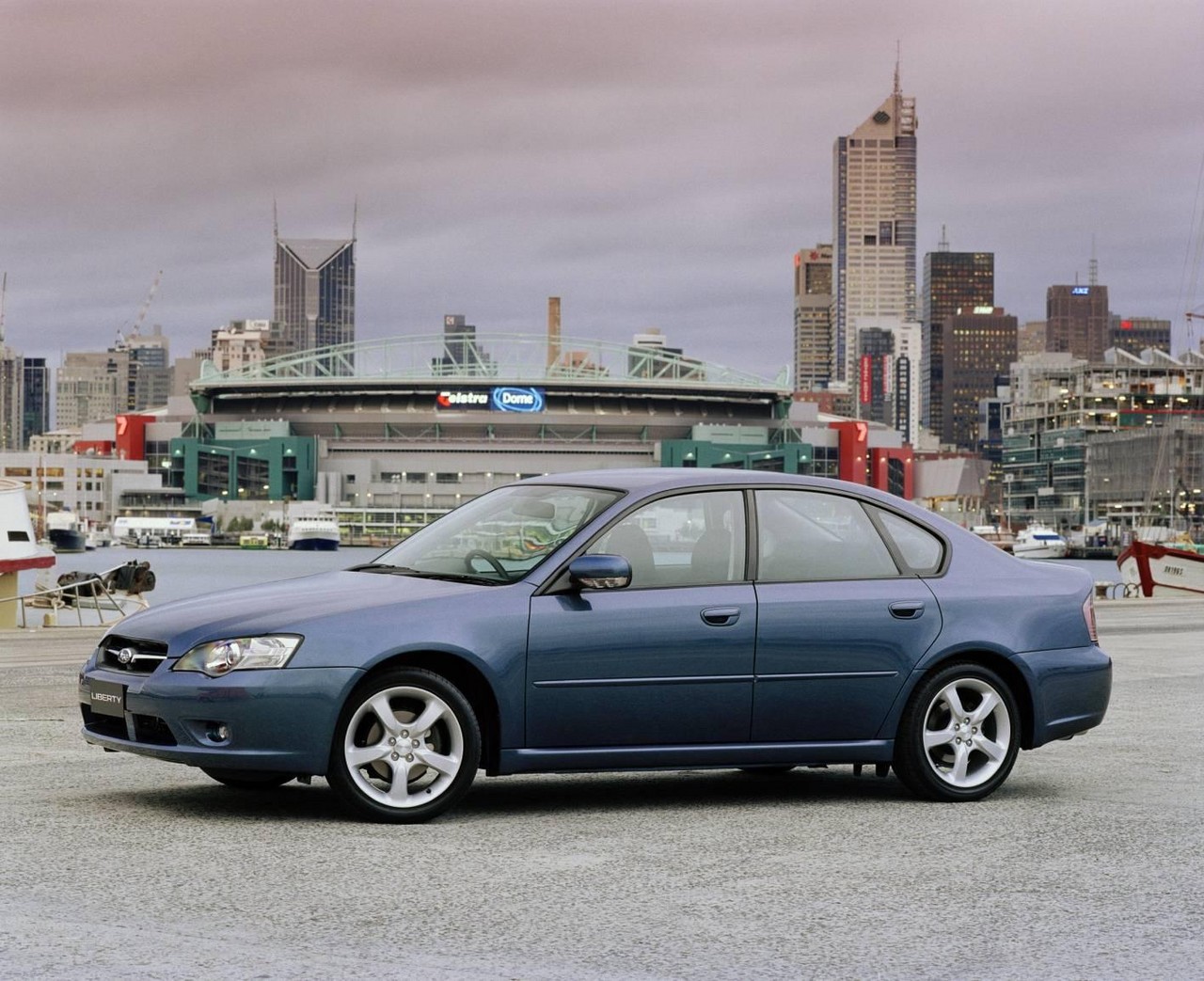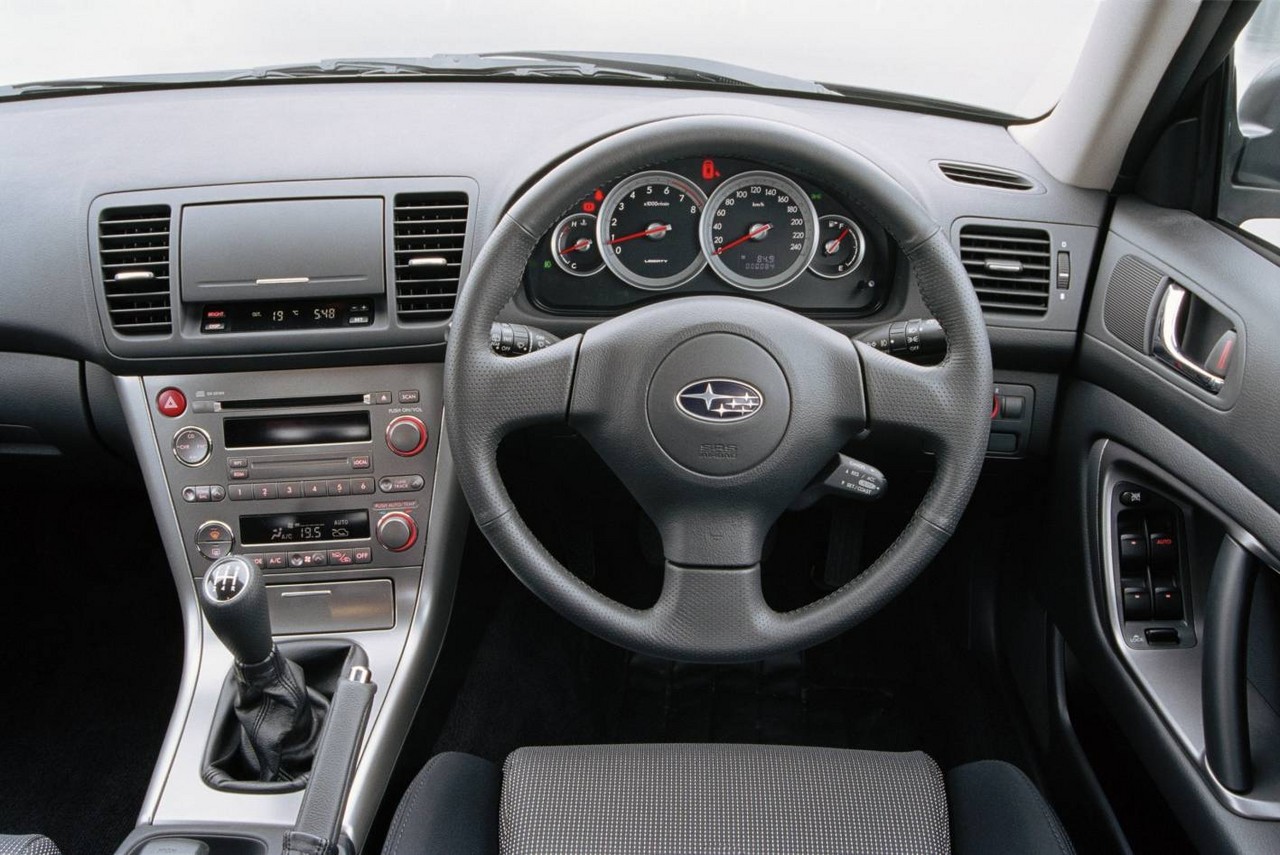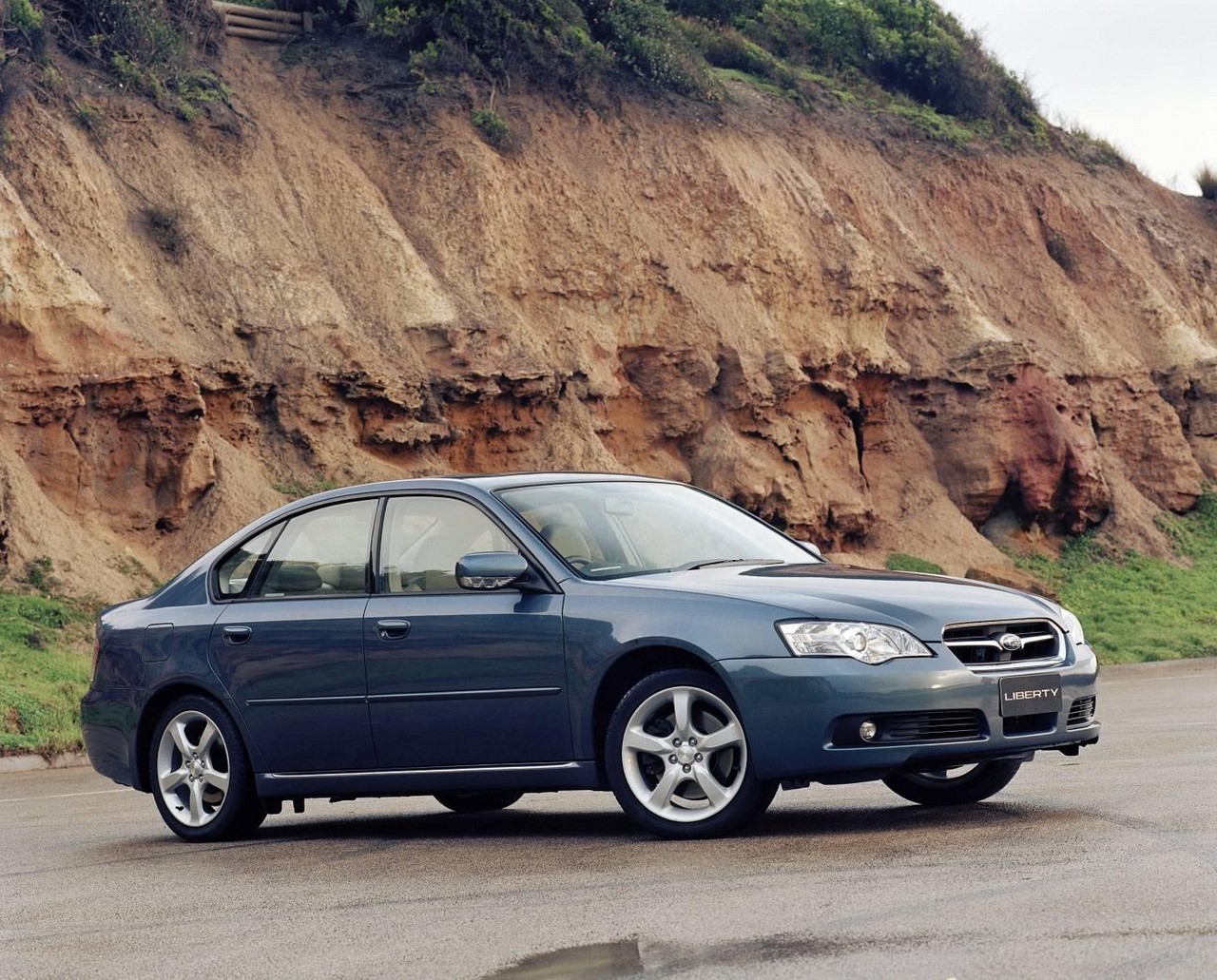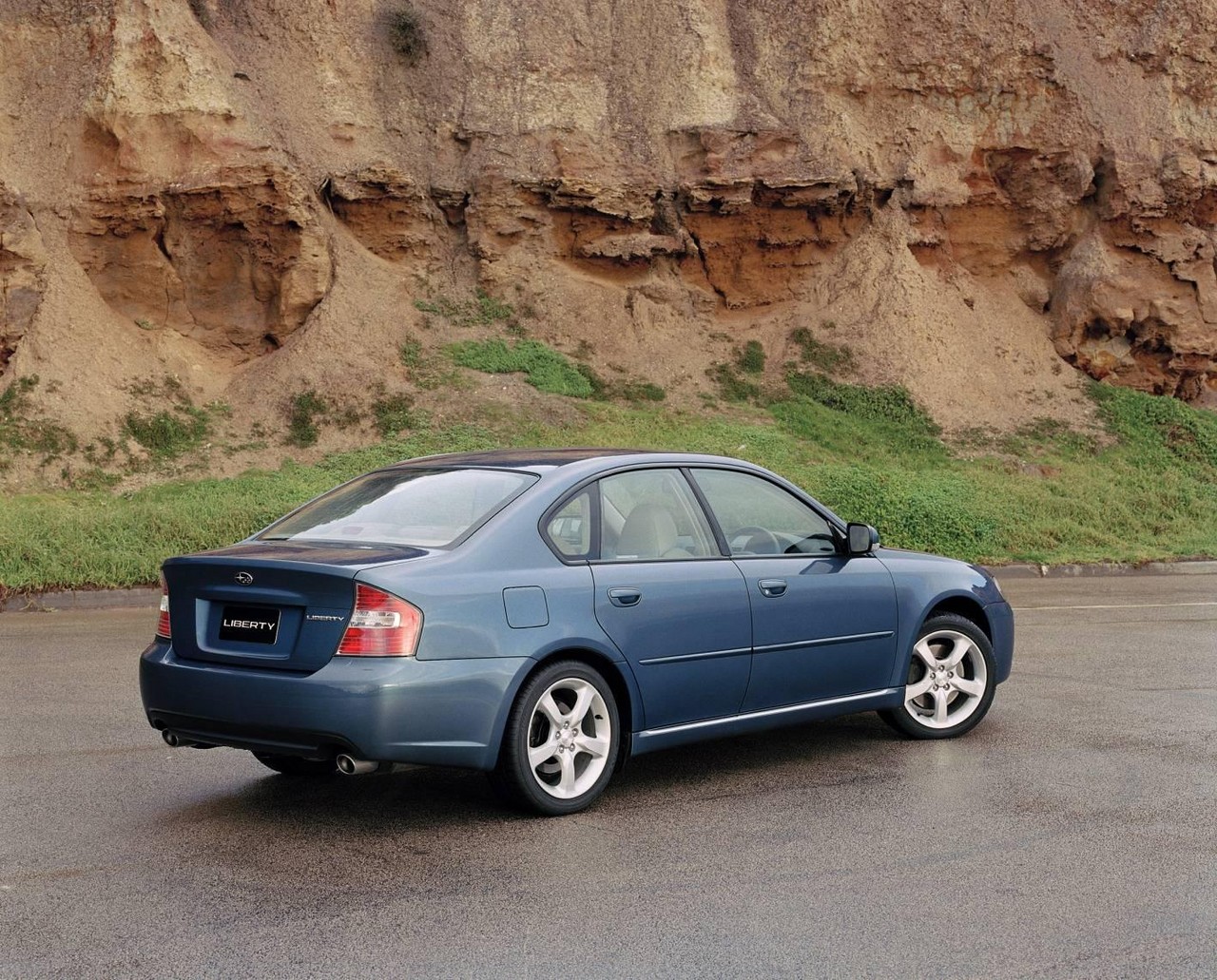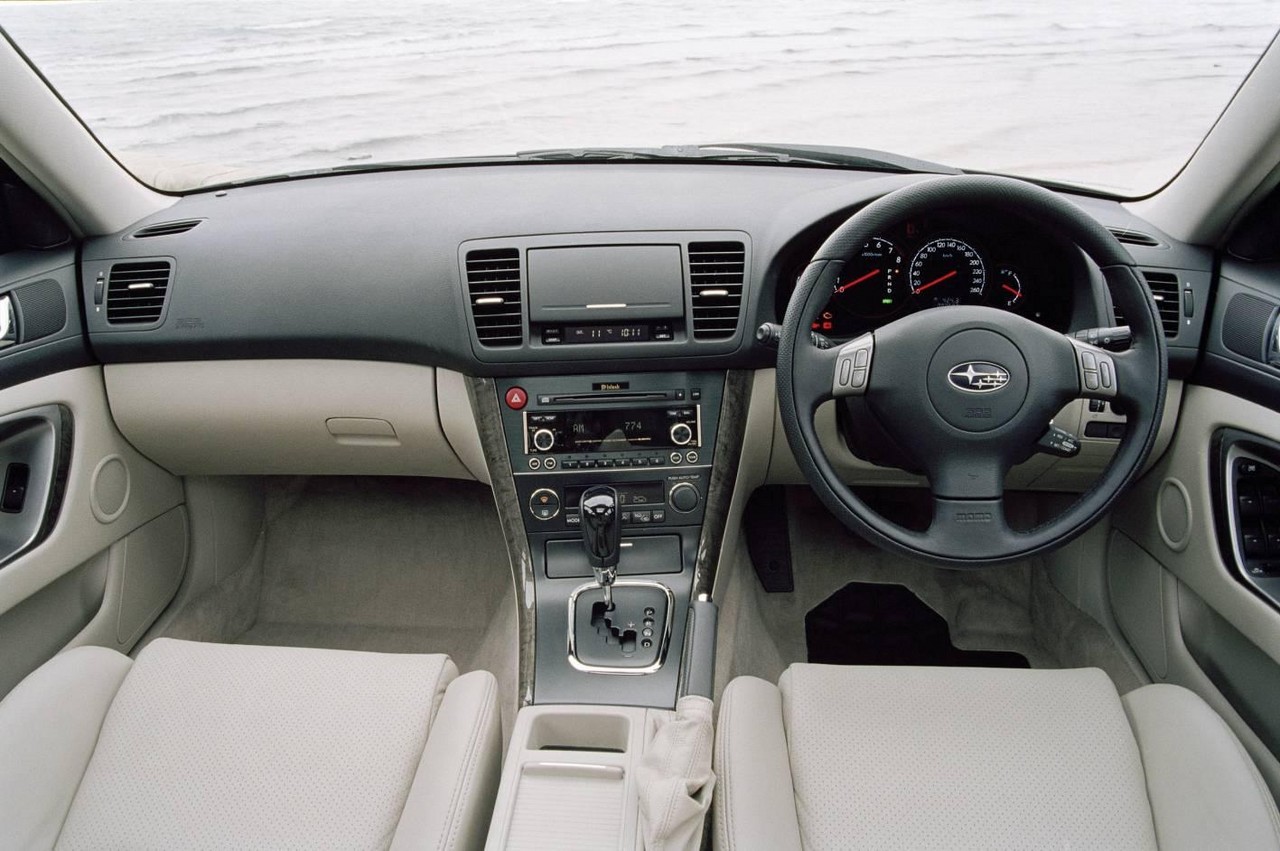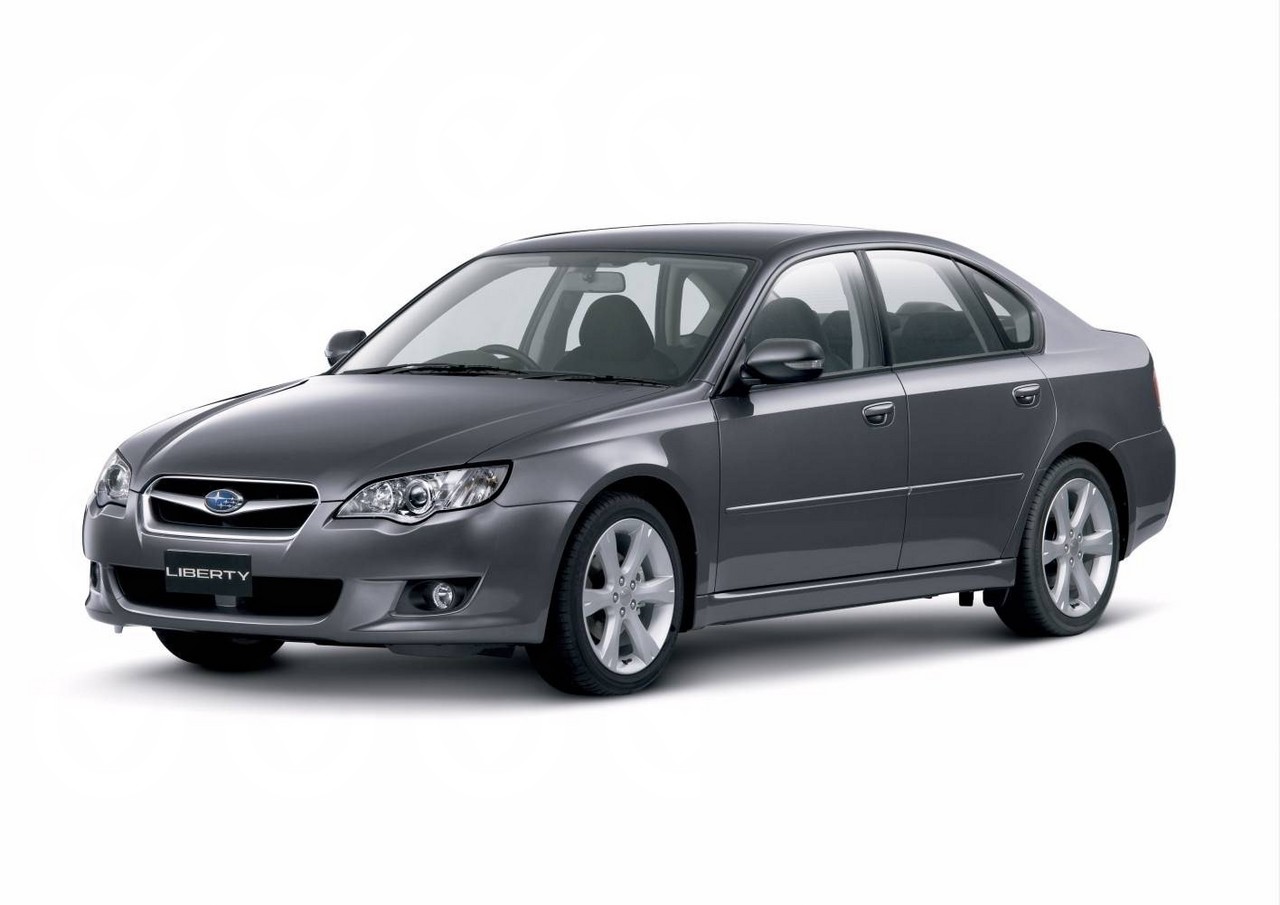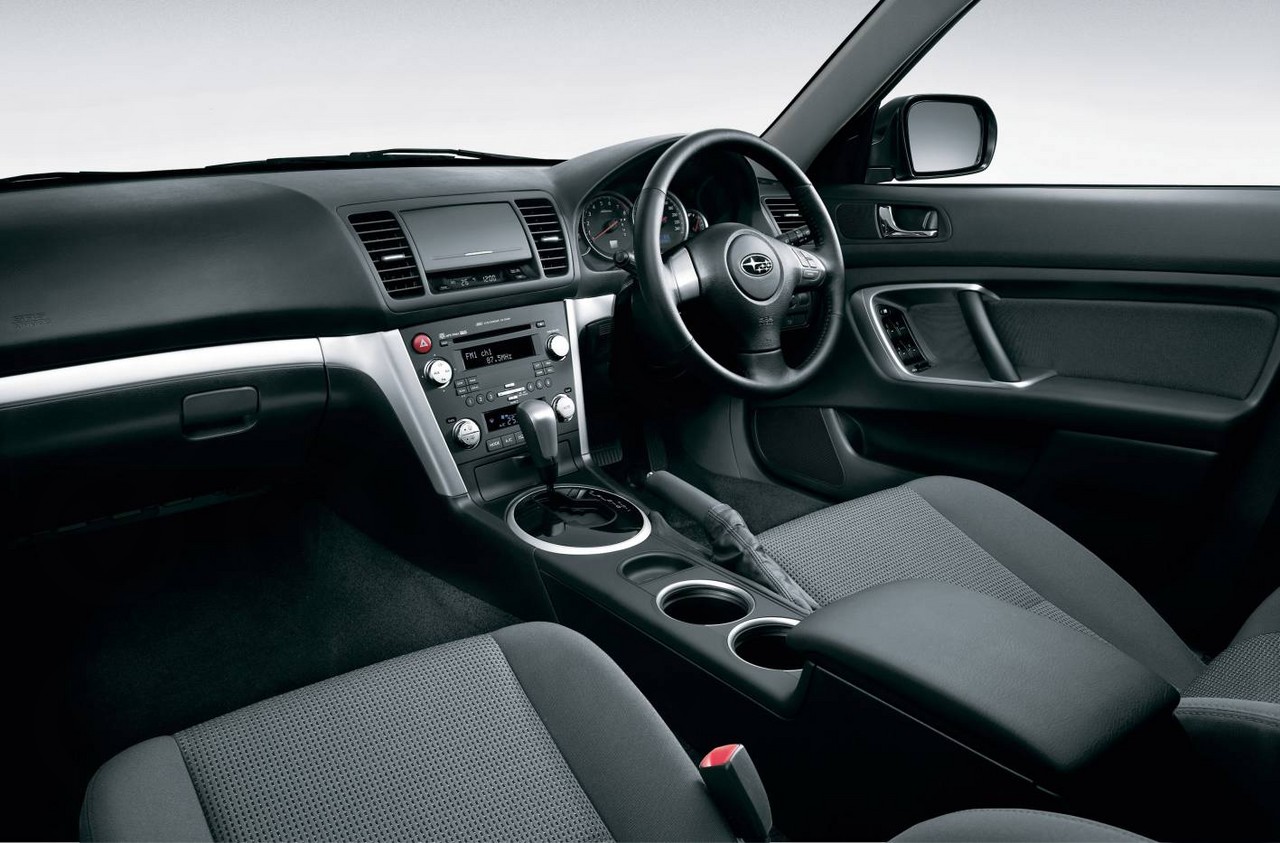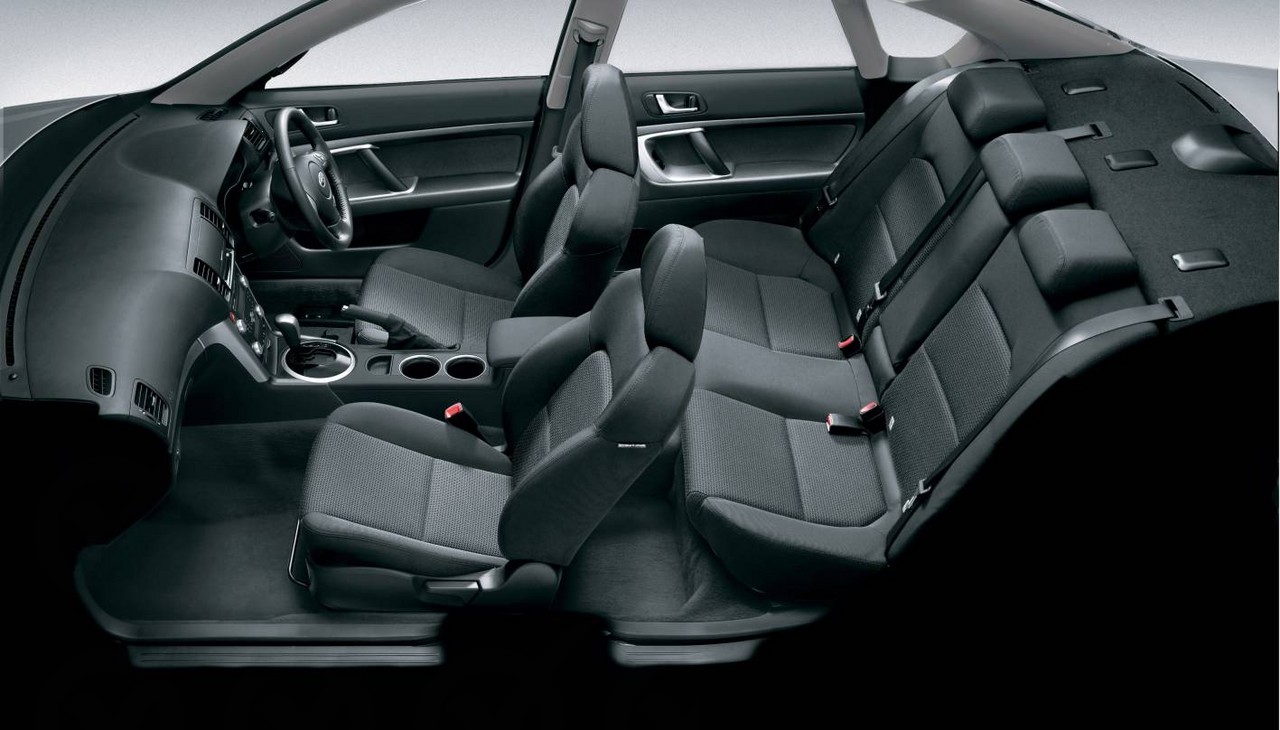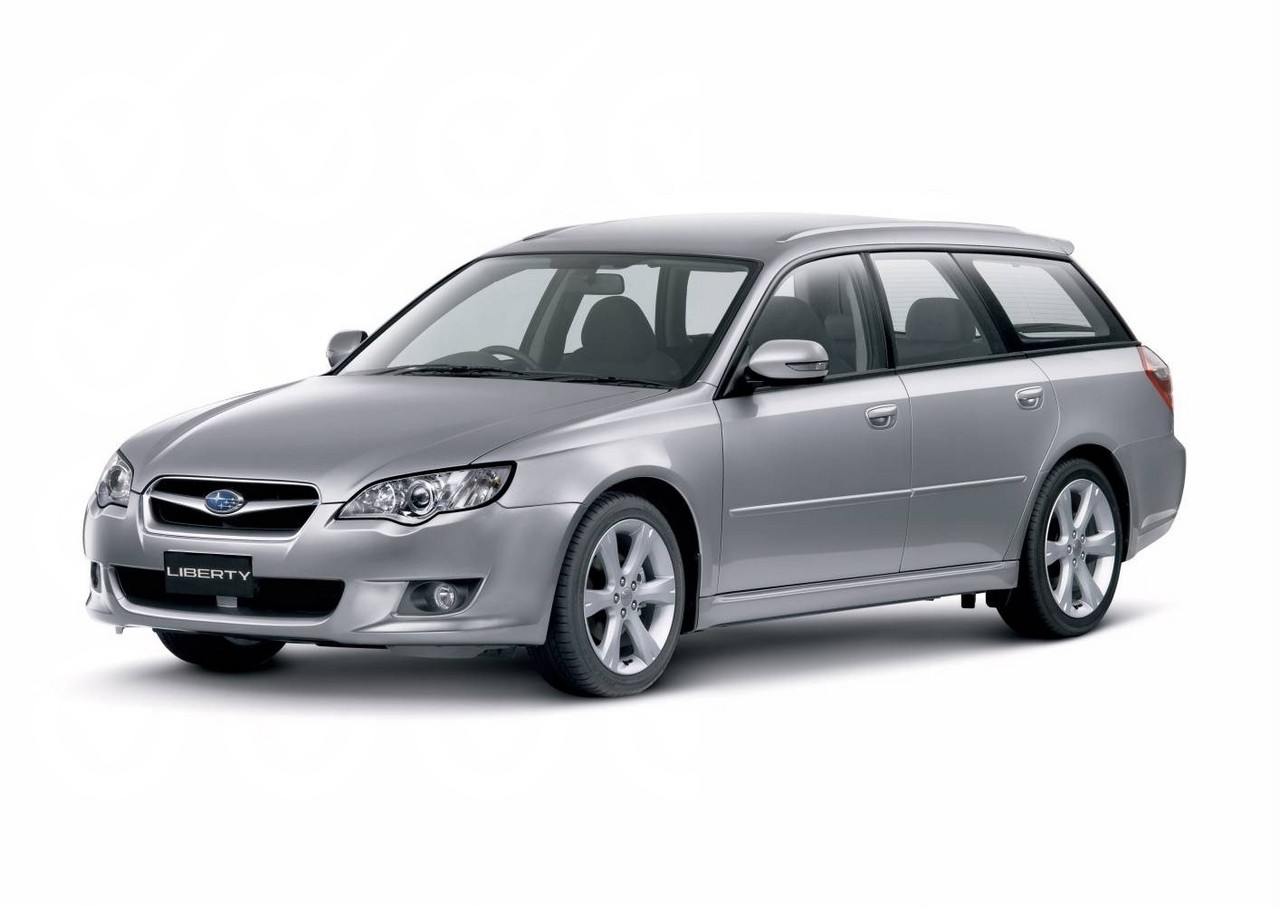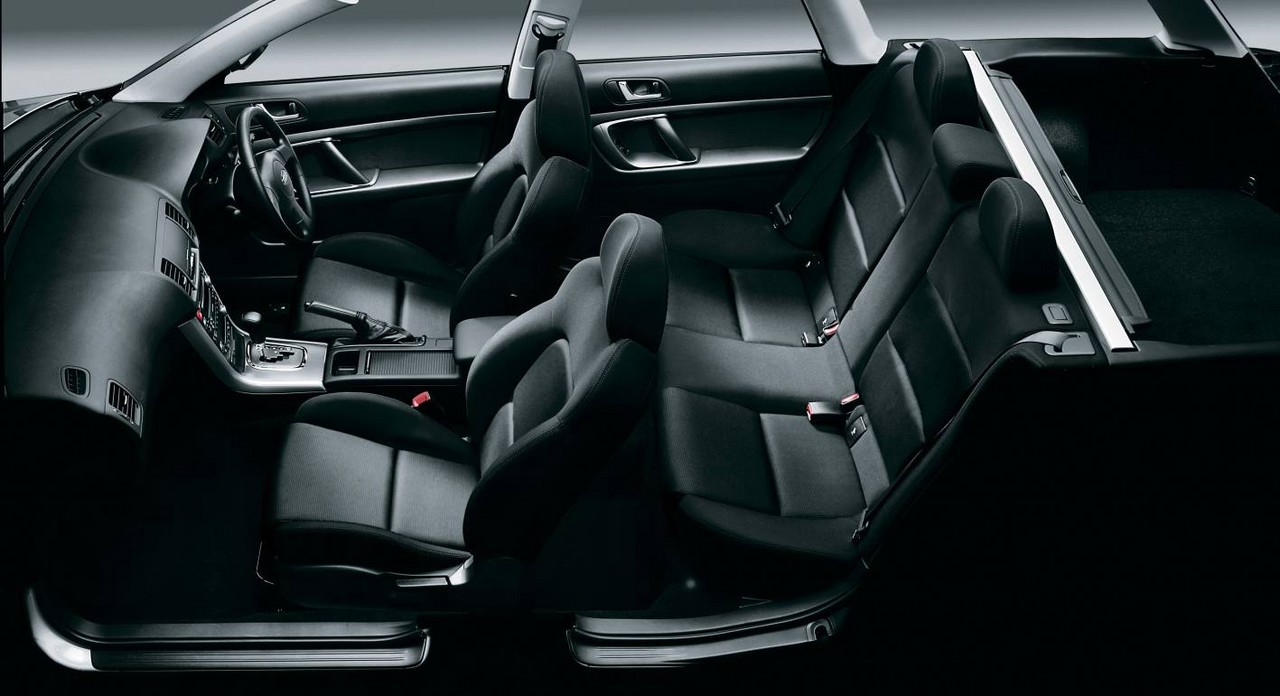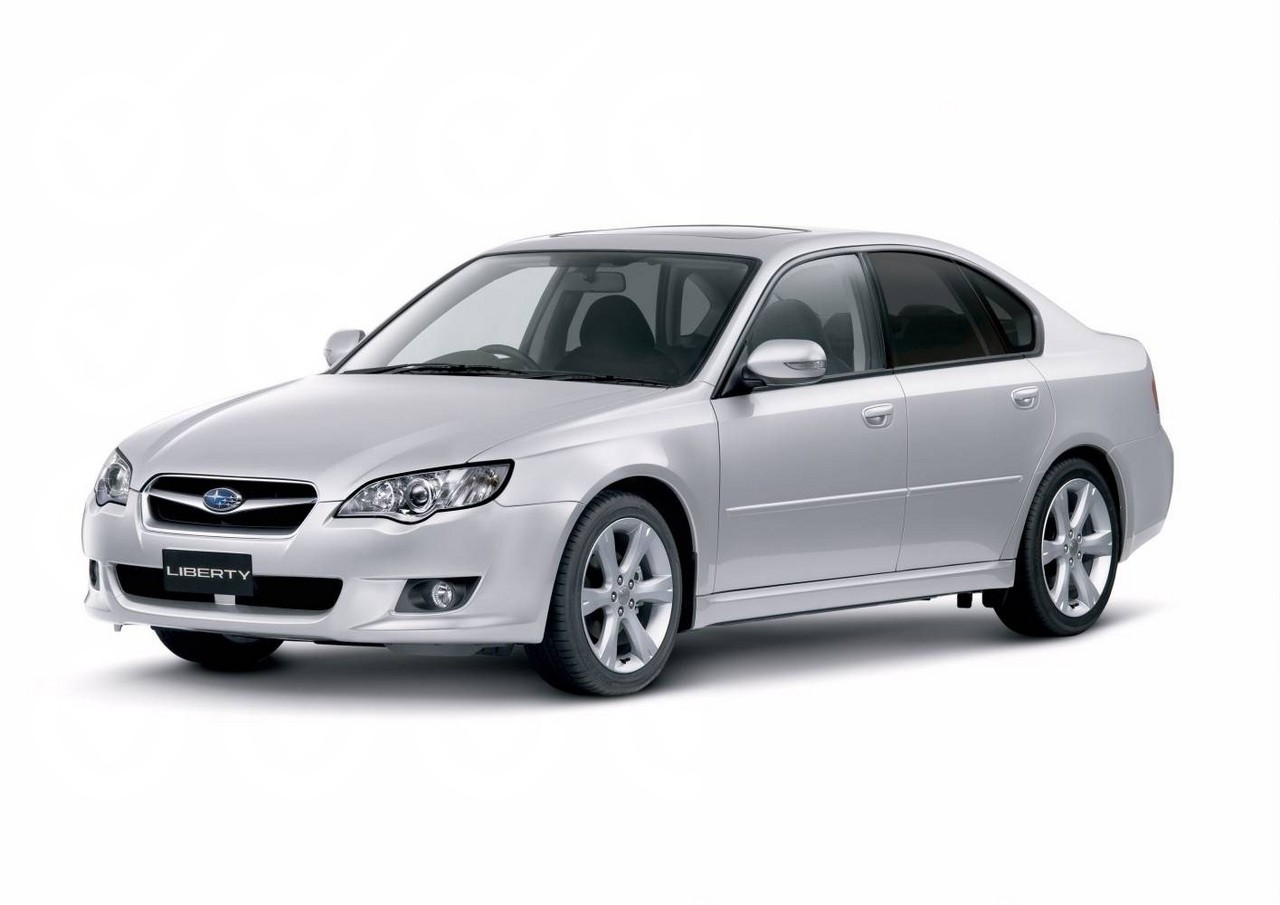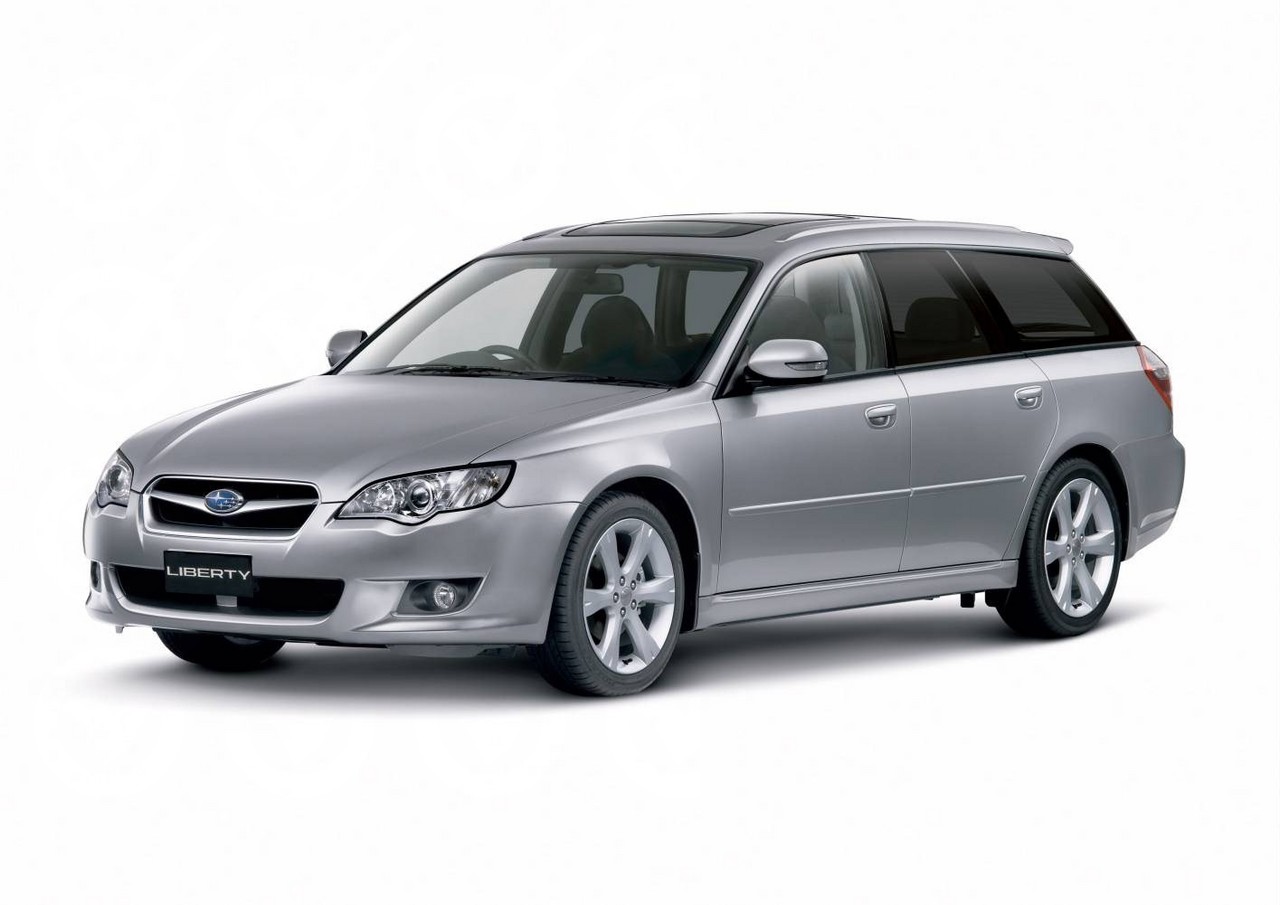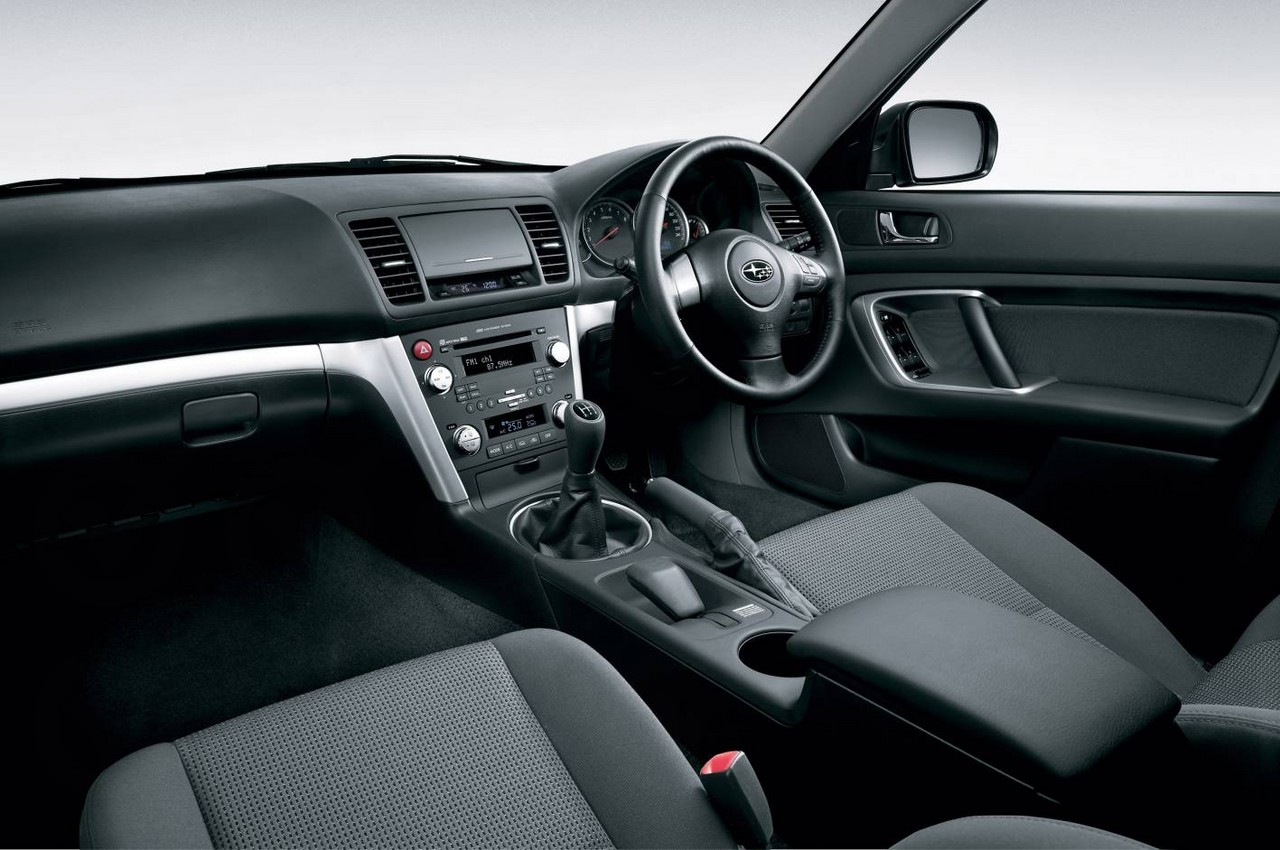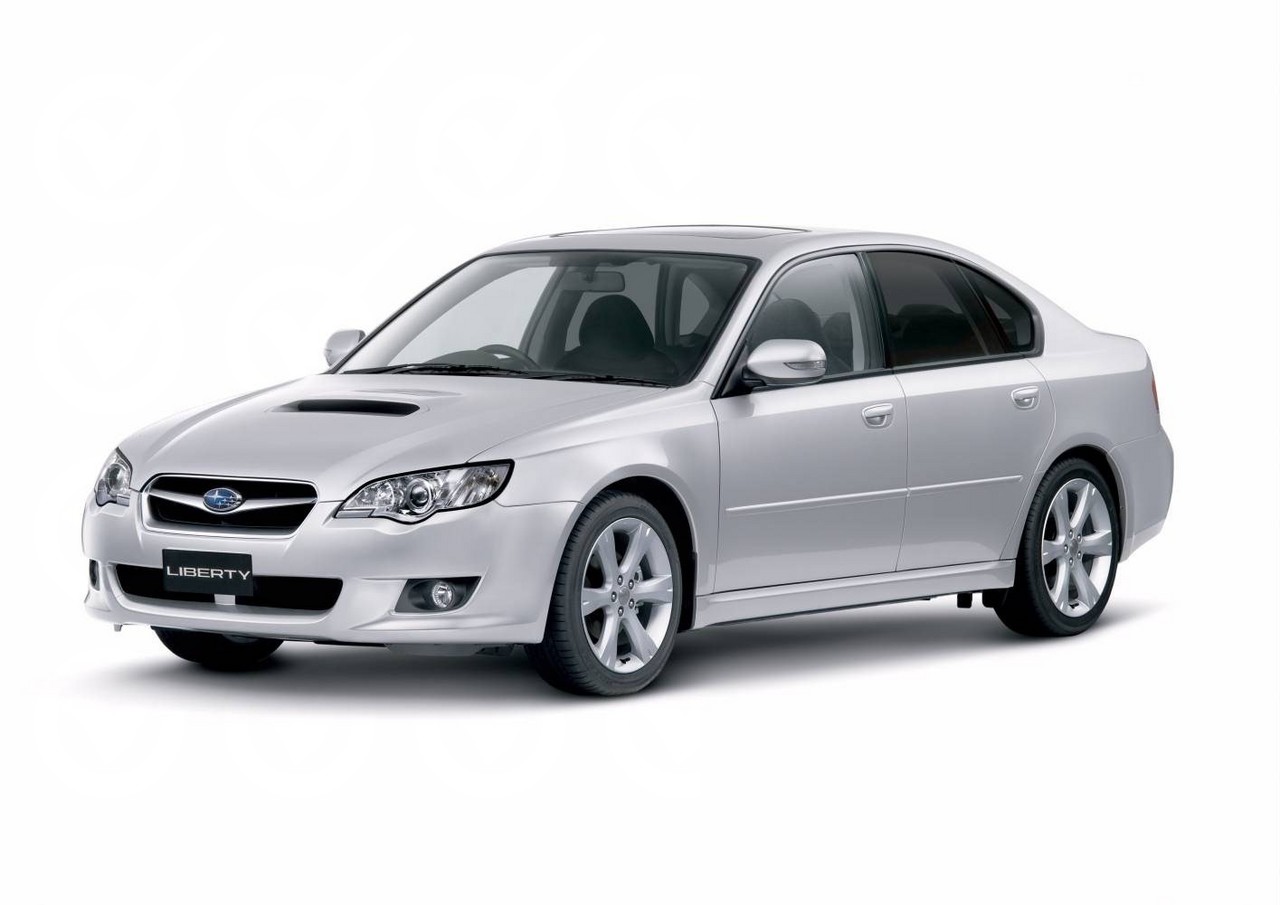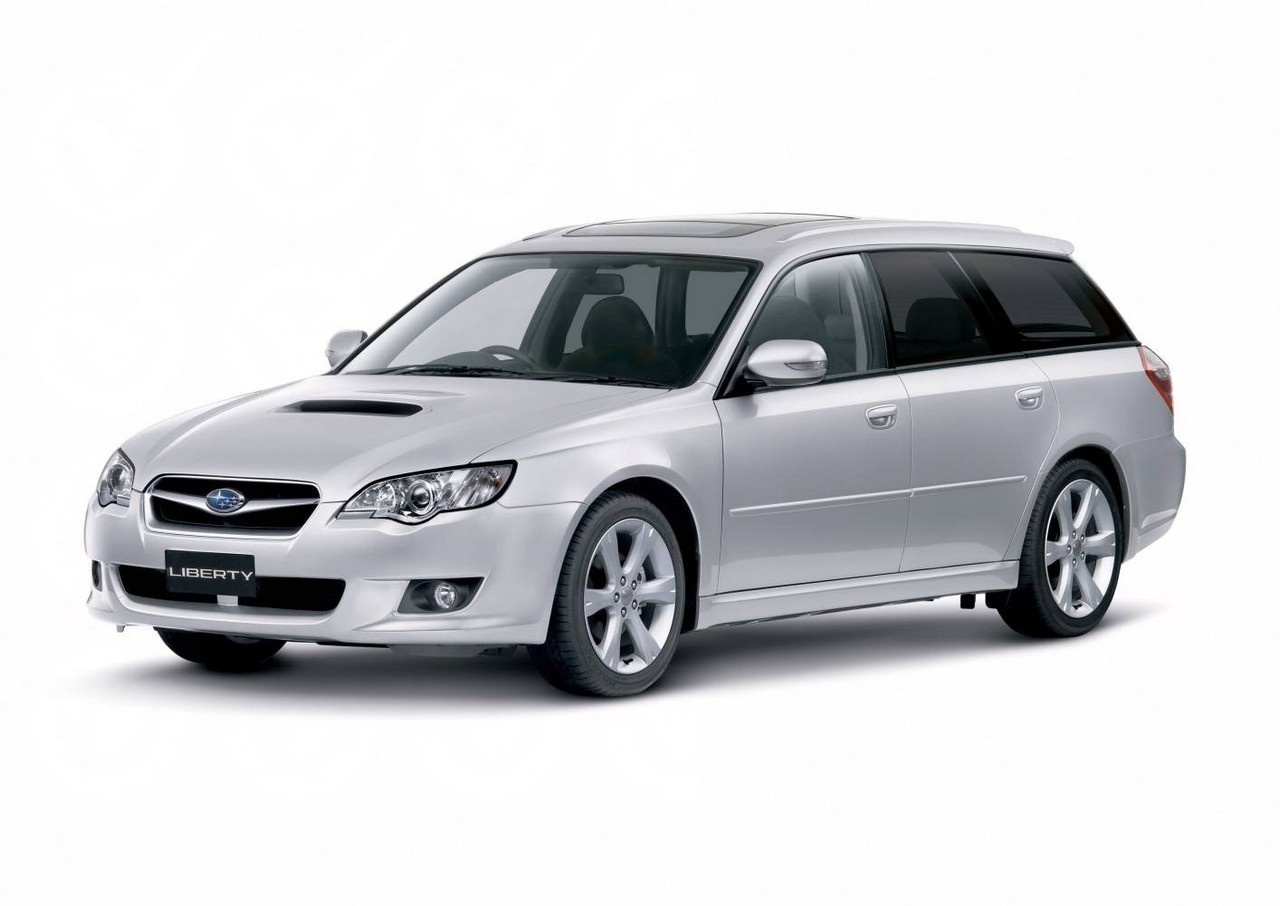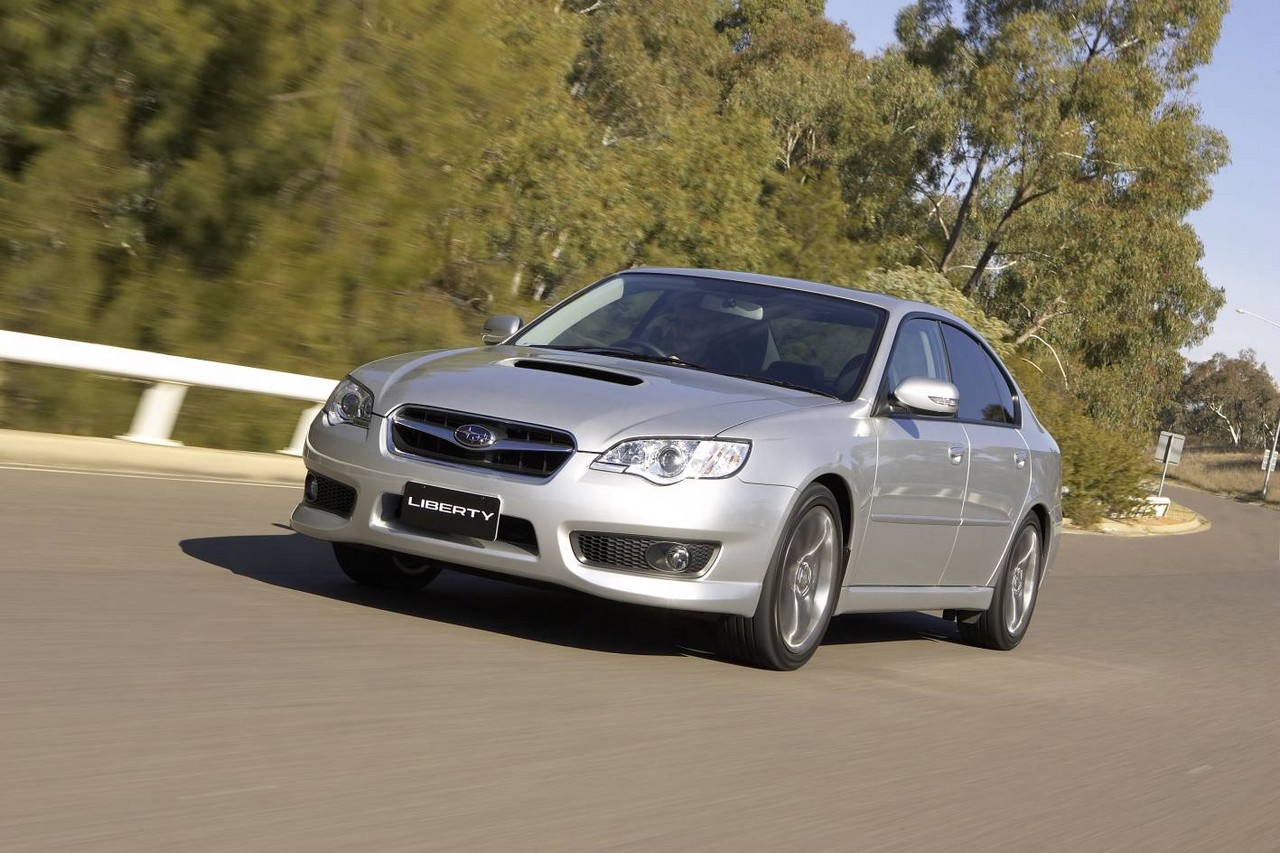
- All-wheel drive traction (via three different systems)
- Accomplished ride/handling balance
- Accurate steering provides good feedback
- High standard of interior fit and finish
- Front seats are supportive…
- … but narrow
- Limited rear seat legroom
- Underpowered 2.0-litre petrol engine
- 2.5-litre petrol engine lacks low-rev torque
- 2.5-litre EJ25 engine susceptible to head gasket failure
Review: Subaru BL.I/BP.I Liberty (2003-06)
Overview
Released in September 2003, the Subaru BL and BP Liberty was available all-wheel drive sedans and wagons, respectively. Manufactured in Ota, Japan, the BL.I and BP.I Liberty range initially consisted of the 2.0i, 2.5i and 2.0 GT variants (see table below). In August 2004, however, the range was updated and expanded with the introduction of the 3.0R and 3.0R-B variants, along with a manual 2.0 GT. For 2006, the 2.5i variant was effectively replaced by the 2.0R.
EJ202, EJ204, EJ252, EJ20X, EJ20Y and EZ30R engines
Of the engines,
- For the Liberty 2.0i and 2.5i, the 2.0-litre EJ202 and 2.5-litre EJ252 engines both had an open-deck aluminium alloy cylinder block with cast iron liners, an aluminium alloy cylinder head with cross-flow cooling, a single overhead camshaft per cylinder bank (belt-driven), four valves per cylinder, multi-point sequential fuel injection and a compression ratio of 10.1:1;
- For the Liberty 2.0R, the EJ204 engine had an open-deck aluminium alloy cylinder block, an aluminium alloy cylinder head with cross-flow cooling, double overhead camshafts per cylinder bank (belt-driven), four valves per cylinder actuated by roller rocker arms, Subaru’s ‘Active Valve Control System’ (AVCS) which provided variable intake valve timing, and a compression ratio of 10.0:1;
- For the Liberty GT, the 2.0-litre EJ20X and EJ20Y engines had an open deck aluminium alloy block, a forged crankshaft and connecting rods, an aluminium alloy cylinder head with cross flow cooling, double overhead camshafts, four valves per cylinder, four valves per cylinder, variable intake and exhaust valve timing (Subaru’s ‘Dual AVCS’) and a compression ratio of 9.5:1. While the EJ20X (automatic transmisson) engine had a twin-scroll IHI VF38 turbocahrger, the EJ20Y engine (manual transmission) had a larger twin-scroll Mitsubishi TD04 HLA 19T turbocharger; and,
- For the Liberty 3.0R, the 3.0-litre EZ30R engine had an open deck aluminium alloy block with cast iron liners, an aluminium alloy cylinder head, double overhead camshafts (chain-driven), four valves per cylinder, variable intake valve timing (Subaru’s ‘Active Valve Control System’ or AVCS), variable intake valve lift (Subaru’s ‘Variable Valve Lift’ or VVL) and a compression ratio of 10.7:1.
Dimensions and development
Compared to the Subaru BE Liberty , the BL Liberty sedan was 60 mm longer (at 4665 mm), 35 mm wider (1730 mm), 10 mm taller (1425 mm) and had a 20 mm longer wheelbase (2670 mm). Relative to its BL sedan counterpart, the BP Liberty wagon was 55 mm longer and had a 45 mm higher roofline. Furthermore, the BL/BP Liberty range was 60 kilograms lighter (on average), achieved a 10 per cent increase in body rigidity, introduced ‘drive by wire’ throttle control, more powerful engines, improved braking performance and greater aerodynamic efficiency (drag coefficient of 0.28 Cd for the sedan and 0.30 Cd for the wagon).
Suspension
The BL/BP Liberty range had MacPherson strut front suspension and multi-link rear suspension (both with coil springs, gas-filled dampers and anti-roll bars).
| Variant | Editions | Years | Engine | Trans. | Peak power | Peak torque |
|---|---|---|---|---|---|---|
| 2.0i | [N/A] | 2003-05 | 2.0-litre EJ202 petrol F4 |
4sp auto, 5sp man. |
101 kW at 5600 rpm | 187 Nm at 4400 rpm |
| Luxury | 2005 | |||||
| 2.0R | [N/A] | 2006 | 2.0-litre EJ204 petrol F4 |
4sp auto, 5sp man. |
121 kW at 6800 rpm | 187 Nm at 3200 rpm |
| Limited (sedan only) |
2006 | |||||
| 2.5i | [N/A] | 2003-05 | 2.5-litre EJ252 petrol F4 |
4sp auto, 5sp man. |
121 kW at 5600 rpm | 226 Nm at 4400 rpm |
| Premium Pack | 2003-06 | |||||
| Safety Pack | 2003-06 | |||||
| Luxury | 2003-04 | |||||
| GT | [N/A] | 2003-05 | 2.0-litre EJ20X turbo petrol F4 |
5sp auto | 180 kW at 6400 rpm | 310 Nm at 2400 rpm |
| Premium Pack | 2003-04 | |||||
| [N/A] | 2004-05 | 2.0-litre EJ20Y turbo petrol F4 |
5sp man. | 190 kW at 6400 rpm | 330 Nm at 2400 rpm | |
| Tuned by STI | 2006 | 2.0-litre EJ20X turbo petrol F4 |
5sp auto | 190 kW at 6400 rpm | 343 Nm at 2400 rpm | |
| 2.0-litre EJ20Y turbo petrol F4 |
5sp man. | 200 kW at 6400 rpm | 343 Nm at 2400 rpm | |||
| 3.0R | [N/A] | 2005-06 | 3.0-litre EZ30R petrol F6 |
5sp auto | 180 kW at 6600 rpm | 297 Nm at 4200 rpm |
| 3.0R-B | [N/A] | 2004-06 | 3.0-litre EZ30R petrol F6 |
6sp man. | 180 kW at 6600 rpm | 297 Nm at 4200 rpm |
| Blitzen | 2006 | 3.0-litre EZ30R petrol F6 |
5sp auto, 6sp man. |
AWD systems
The Subaru BL/BP Liberty was available with three different all-wheel drive (AWD) systems:
- Liberty models with manual transmissions were fitted with Subaru’s ‘Continuous’ AWD system which utilised a viscous-coupling locking centre differential. In normal conditions, the system provided a 50:50 front/rear torque distribution. If traction was lost, however, up to 80 per cent of the engine’s torque could be directed to the opposing axle. The manual 2.0i, 2.5i, 2.0R wagons were also equipped with dual range transmissions.
- For Liberty 2.0i, 2.0R and 2.5i variants with automatic transmissions, an ‘Active Torque Split’ system was fitted, consisting of an electronically-controlled, hydraulic multi-plate transfer clutch (instead of the centre differential). In normal conditions, the system provided an 80:20 front/rear torque split but sensors – measuring wheel slippage, throttle position and braking – could anticipate a loss of front-wheel traction and transfer torque to the rear axle.
- For the Liberty 3.0R, 3.0R-B, 2.0 GT and 2.5 GT variants with automatic transmissions, a ‘Variable Torque Split’ system was fitted; this system utilised an electronically-controlled, hydraulic multi-plate clutch which operated in conjunction with the centre planetary-type differential. In normal conditions, the system provided a 45:55 front/rear torque split, though sensors – monitoring wheel slippage, throttle position and braking – could determine the amount of clutch lock to apply.
Safety equipment
Standard safety equipment for the Subaru BL/BP Liberty included dual front airbags (with two-stage inflation), ABS, electronic brake force distribution, active front seat head restraints and front seatbelts with pretensioners and load limiters; the 2.0 GT added front side airbags (with head protection). Compared to the standard safety equipment, the 2.0R, 3.0R and 3.0R-B were further equipped with front side airbags and curtain airbags, with the automatic 3.0R also fitted with electronic stability control and traction control.
For the Liberty 2.5i, the Safety Pack added front side airbags and full-length curtain airbags, while the 2.5i Premium Pack also included electronic stability control. Similarly, the Liberty GT Premium Pack added front side airbags and full-length curtain airbags, but omitted electronic stability control. From August 2004, all Liberty 2.5i and GT variants were fitted with front side airbags and the driver’s seatbelt was fitted with a double pretensioners across the range.
ANCAP crash testing
In ANCAP crash testing , Subaru Liberty models that were fitted with the standard safety equipment received a five star adult occupant protection rating with a score of 32.57 out of 37. However, Liberty models that were further equipped with front side airbags and curtain airbags received a score of 35.52. Both these ratings pre-dated ANCAP’s requirement that vehicles must be fitted with electronic stability control in order to achieve a five star rating.
Features: Liberty 2.0i, 2.5i and 2.0R
Standard features for the Liberty 2.0i included 16-inch alloy wheels, a six speaker Kenwood sound system with CD player, air conditioning, cruise control, remote central locking, power mirrors and windows, map lights, vanity mirror, a tilt adjustable steering column, height adjustable driver’s seat and an immobiliser. Furthermore, sedans had a ‘centre-through’ rear seat, while wagons had a 60/40 split and folding rear seat, cargo blind and rear spoiler.
Compared to the 2.0i, the Liberty 2.5i and 2.0R added 17-inch alloys, climate control air conditioning, front fog lights and a leather-wrapped steering wheel, gearshift and park brake handle; the 2.5i Safety Pack and 2.5i Premium Pack were further equipped with a sunroof. The 2.5i Luxury Pack omitted the sunroof but added a six-stack CD player, leather seats and an eight-way power adjustable driver’s seat; the 2.5i Premium Pack restored the sunroof.
Features: Liberty 2.0 GT, 3.0R and 3.0R-B
Compared to the 2.5i and 2.0R, the Liberty 2.0 GT was further equipped with a six-stack CD player, cassette player and a Momo leather-wrapped steering wheel with ‘Sportshift’ gearshift controls; the 2.0 GT Premium Pack added a 13-speaker McIntosh sound system, leather seats, an eight-way power adjustable driver’s seat and sunroof.
Relative to the 2.0 GT, the Liberty 3.0R was differentiated by its 17-inch alloy wheels, 13 speaker McIntosh sound system with six-stack CD player, ivory leather trim, cruise control, eight way power adjustable front seats, power sunroof and leather-wrapped gearshift and park brake. The 3.0R-B (subsequently referred to as the 3.0R spec.B) was distinguished by its 18-inch alloy wheels, Bilstein suspension, black leather seats and alloy pedals.
August 2004: Liberty update
In August 2004, the BL/BP.I Liberty range underwent a minor update, with a shift-lock mechanism introduced for all automatic transmissions such that the ignition had to be switched to ‘on’ and the brake pedal depressed before the gear shifter could be moved from ‘Park’. Other changes included speed-sensitive intermittent windscreen wiper control and the trip computers were modified to show fuel consumption in litres per 100 kilometres.
2006 Liberty 2.0R Limited Edition
In January 2006, a 2.0R Limited edition was released. The 2.0R Limited was only available as a sedan and featured 17-inch alloy wheels, combination leather/alcantara seats, tinted glass, rear boot spoiler and either a yellow or white paint finish.
2006 Liberty 3.0R-B Blitzen
In June 2006, a 3.0R-B Blitzen edition was released. Compared to the standard 3.0R-B, the 3.0R-B Blitzen was differentiated by its 18-inch alloy wheels, bright red or obsidian black paint finishes and its unique aerodynamic package which included a larger, honeycomb grille, wider bumpers, flared side sills and, for wagon models, a roof spoiler.
Review: Subaru BL.II/BP.II Liberty (2006-09)
Overview
Released in September 2006, the BL/BP Series II (BL.II/BP.II) Liberty introduced a new EJ255 engine for the Liberty GT, improved equipment levels and a subtle facelift. Visually, the BL/BP Series II Liberty could be identified by its re-shaped nose, headlights, bumpers, front guards and grille. Under the skin, the suspension and braking were enhanced for greater refinement and improved stopping distances.
Liberty GT: EJ255 engine
For the Liberty GT, the turbocharged 2.5-litre EJ255 engine had a semi-closed die-cast aluminium block with cast iron liners, an aluminium cylinder head with cross-flow cooling, double overhead camshafts per cylinder bank (belt-driven), four valves per cylinder, variable intake valve timing (Subaru’s ‘Active Valve Control System’ or AVCS), Tumble Generator Valves (TGVs) and a compression ratio of 8.4:1. For the Liberty GT, the EJ255 engine was fitted with an IHI VF46 (RHF5H) turbocharger which provided maximum boost pressure of 95 kPa (13.8 psi).
August 2007: range update and EJ253 engine
In August 2007, the BL.II/BP.II Liberty range was updated: the Liberty 2.0R was discontinued and the 2.5i variants were powered by Subaru’s EJ253 engine . Compared to the EJ252 , changes for the EJ253 engine included:
- Reinforced casting around the engine’s main bearing journal;
- Alterations to cylinder liner shape;
- The introduction of Tumble Generator Valves (TGVs) to reduce start-up emissions; and,
- Subaru’s ‘Intelligent Active Valve Lift’ (i-AVLS) which provided increased valve lift for one intake valve per cylinder.
| Variant | Editions | Years | Engine | Trans. | Peak power | Peak torque |
|---|---|---|---|---|---|---|
| 2.0R | N/A | 2006-07 | 2.0-litre EJ204 petrol F4 |
4sp auto, 5sp man. |
121 kW at 6800 rpm | 187 Nm at 3200 rpm |
| 2.5i | N/A | 2006-09 | 2.5-litre EJ252 petrol F4 |
4sp auto, 5sp man. |
121 kW at 5600 rpm | 226 Nm at 4400 rpm |
| Premium Pack | 2006-07 | |||||
| Premium | 2007-09 | 2.5-litre EJ253 petrol F4 | 4sp auto, 5sp man. |
127 kW at 6000 rpm | 226 Nm at 4400 rpm | |
| Heritage | 2007-09 | |||||
| Sport Edition | 2008-09 | |||||
| GT | N/A | 2006-09 | 2.5-litre EJ255 petrol turbo F4 |
5sp auto, 6sp man. |
184 kW at 6000 rpm | 339 Nm at 3600 rpm |
| Spec.B | 2006-09 | |||||
| Spec.B R | 2009 | |||||
| Tuned by STi | 2007-08 | 2.5-litre EJ255 petrol turbo F4 |
5sp auto, 6sp man. |
194 kW at 6000 rpm | 350 Nm at 2800 rpm | |
| 3.0R | N/A | 2006-07 | 3.0-litre EZ30R petrol F6 |
5sp auto, 6sp man. |
180 kW at 6600 rpm | 297 Nm at 4200 rpm |
| Premium | 2007-09 | |||||
| Spec.B | 2006-09 |
Safety equipment
Compared to their BL.I/BP.I predecessors, standard safety equipment for the BL.II/BP.II Liberty was improved with all models fitted with dual front, front side and curtain airbags; the 2.0R and 2.5i were also equipped with brake assist. The automatic 3.0R was also fitted with electronic stability control and traction control, but the 2.5 GT and 3.0R Spec.B were initially offered with a choice of either electronic stability control and traction control (Subaru’s ‘Vehicle Dynamics Control’) or satellite navigation.
From August 2007, electronic stability control and traction control were standard on all automatic 2.5-litre models (i.e. the 2.5i and 2.5 GT variants); in October 2008, electronic stability control and traction control were made standard across the range.
Features: Liberty 2.0R, 2.5i, GT and 3.0R Spec.B
Compared to its BL.I/BP.I predecessor, standard features for the entry-level 2.0R variant were extended to include 17-inch alloy wheels, a six speaker sound system with six-stack CD player with MP3/WMA compatibility, climate control air conditioning, steering wheel cruise controls and telescopic steering wheel adjustment.
The 2.5i was further equipped with a power sunroof, while the 2.5i Premium and Heritage were fitted with leather seats, an eight-way power adjustable driver’s seat with memory settings and rear privacy glass; from August 2007, the 2.5i Premium was also equipped with a fourteen speaker McIntosh sound system and bi-xenon headlights.
The 2.5 GT featured a fourteen speaker McIntosh sound system, dual zone climate control air conditioning and bi-xenon headlights, while the GT Spec.B and 3.0R Spec.B were distinguished by their 18-inch ten-spoke alloy wheels, Bilstein suspension, strengthened front and rear differentials and limited slip Torsen rear differential.
Subaru Intelligent Drive
Subaru Intelligent Drive(SI-D) was fitted to all turbocharged and 3.0-litre Libertys; this enabled the driver to select from Intelligent, Sport and Sport Sharp modes for economy or performance settings.
October 2008: Liberty update
From October 2008, the BL.II/BP.II Liberty was fitted with leather seats and an auxiliary sound system input as standard. Satellite navigation was also fitted to the 2.5i Premium, 2.5 GT, 2.5 GT Spec.B, 3.0R Premium, 3.0R and Spec.B.
2.5 GT Tuned by STi
In April 2007, the 2.5 GT Tuned by STi was released; compared to the standard 2.5 GT, the Tuned by STi editions had more powerful engines, 18-inch Enkei alloy wheels with Pirelli P-Zero Rosso tyres, Bilstein sports-tuned dampers with lowered springs, pillow-ball bush suspension components, upgraded Brembo brakes, sports mufflers, front lip spoiler and – for sedans – a rear boot spoiler. Furthermore, automatic models had a revised transmission control unit for faster gear shifts, while manuals had a short-shift STi gear lever.
Related links
